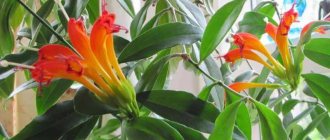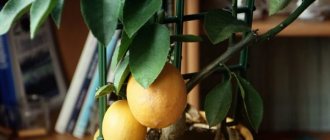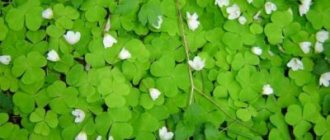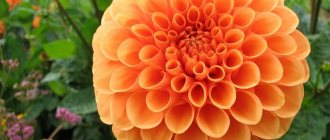Strelitzias are evergreen, herbaceous perennials with unusual flowers and equally exotic leaves, which in their natural environment can reach ten meters in height.
The way the flower is formed and the way Strelitzia is pollinated deserves special attention. The shell from which the “paradise” flower is born is positioned horizontally relative to the surface before flowering and has the shape of a bird’s “beak”. This shell has its own name - “spathe”, which translates as “wrapper”, and can have a length, depending on the type of sterlitium, up to half a meter. The flowers emerge directly from the involucre and have a number of petals, with several joining together in an arrow-shaped shape to form a "nectary". At the moment when a bird, attracted by nectar, lands on a flower, the petals open, throwing pollen onto it, which the bird transfers to other plants.
These green inhabitants of the African continent became known to Europeans at the end of the 18th century thanks to the Scottish naturalist Francis Masson. The name of the genus is given in honor of the English queen. The genus has five species, which are described in detail below. In addition to the main species, there are many hybrids.
Features of the plant
South Africa is the birthplace of an exotic beauty. There is especially a lot of it on the coast of South Africa. Here Strelitzia grows along the banks of drying streams and on fertile loose sandstones in the humid subtropics.
Strelitzia (the name strelitzia is often used) are perennials with dark green concave leaves of a wide elliptical shape. The height of bushes in the natural environment can range from one and a half to ten meters.
The flowers are similar to the heads of unusual birds. Each of them has a picturesque crest. No wonder the second name of Strelitzia is bird of paradise. The originality of the flower is undeniable, surpassing even the amazing “lipstick” plant Aeschynanthus.
The heads of the “birds of paradise” open on long peduncles. The bud looks like a narrow gray capsule located at an angle to the peduncle. When ready to bloom, it forms a narrow gap at the top through which large, bright sepals and petals pop out. Looks very similar to a peacock's crest.
The sepals of most plant species are yellow-orange, the petals are blue or with a purple tint. The photo of Strelitzia shows how tightly the blue petals are closed. There the flower covers the stamens with pollen and nectar.
Upon completion of flowering, a fruit is formed in the form of a capsule with seeds. Strelitzia also has unusual seeds - black peas with a fuzzy orange tuft.
The decorative qualities of the plant served as an effective reason to use it in gardening and landscape design. Strelitzia then moved into indoor culture.
Annual flowering occurs after the plant is 4-5 years old. Adult specimens (over 8 years old) love to live in voluminous tubs and require space to match their size.
Strelitzia tolerates varying soil acidity and salinity well. Genetically, the plant hardened, spreading in coastal areas in open space and getting used to sea winds and unstable weather. Cyperus loves this kind of habitat.
Types of Strelitzia
Several plant species grow in the natural environment. First of all, their difference is in size. Some can be two meters tall with leaves up to half a meter long. Others grow up to 10 m. The leaves of such strelitzia can be more than 80 cm in length.
Naturalists have discovered and described five species of representatives of the Strelitziaceae genus:
- Strelitzia reginas;
- Strelitzia Nicholas;
- Strelitzia rush;
- strelitzia montana (tailed);
- Strelitzia Augusta or white.
Any of them can be found not only in hot Africa, but also in those countries where winters are mild and warm. For example, in Central America, Argentina, on the shores of the Mediterranean.
Interesting fact: in Los Angeles, the city residents love the flower so much that they made it a symbol of the city for its extraordinary beauty and long flowering. Moreover, there were many proposals to depict a flower on the city's coat of arms.
In our latitudes, it grows only in greenhouse conditions or in the apartments of flower lovers.
Strelitzia reginas
Of the listed species, the most common is the royal strelitzia. The Latin name is strelitzia reginae.
The delightful flower received its name from the English who discovered it. While in South Africa in the 18th century and seeing the plant, they were so impressed by its beauty that they decided to give it the name of Charlotte of Mecklenburg-Strelitz, the wife of the reigning King George.
The plant can stretch up to 2 m. Its peduncles grow higher than the leafy bush. Intricate flowers, like birds with elongated heads, peek out from above. Africans call Strelitzia crane because of the unusual appearance of the flower.
An herbaceous perennial, it has a shortened stem and a rosette of 6-8 hard, double-rowed leaves, shaped like banana leaves.
Blooms in September and blooms until February. Flowers can last up to one month, and new ones open to replace faded ones. When cut and placed in vases, they do not lose their fresh appearance for a long time.
Strelitzia Nicholas
The flower received its unusual name in honor of Grand Duke Nikolai Nikolaevich the Elder. A rare specimen was presented to Tsar Nicholas I. Subsequently, Strelitzia bloomed for the first time in the Botanical Garden of St. Petersburg.
The director of the garden, E.L. Rigel, began to study the exotic novelty and determined that it was an unknown species at that time. Rigel decided to give him the name of the king's third son. Nikolai the Elder was in charge of the botanical garden at that moment.
Strelitzia Nicholas is the largest representative of this species. In the tropics of Africa, in open ground it can grow more than 10 m. The crown girth can be 4 m. Its flowers are formed at the level of leaf cuttings and reach a length of 17 cm.
The color is completely different. Flowers with blue-white petals emerge from a bluish-green bract outlined with a reddish border. Flowers appear late, in the 8th year of growth.
Due to dead and fallen leaves, scars form on the trunk. As it grows, it begins to become woody and resembles a palm tree trunk.
In floriculture, the species Strelitzia Nicolai has spread as an ornamental foliage plant.
The attractive foliage of young specimens, which do not require labor-intensive care, perfectly decorates the premises.
Strelitzia ruminata
Strelitzia (lat. Strelitzia juncea) is strikingly different from its species relatives. Although this is the same herbaceous perennial, it grows as a bush, but its appearance is different. It's all about the leaves.
Each leaf of the Strelitzia rush is thin and cylindrical in shape. In everyday life it is often called the “narrow-leaved flower of paradise.” There is also the name Strelitzia reed.
The flowers are close in color to the royal strelitzia reginae.
3.Varieties:
3.1.Strelitzia Reginae
Perennial, evergreen, herbaceous plant that can reach 180 cm in height. A distinctive feature of the species is that the flowering period can occur several times during the season if this Strelitzia receives proper care. Strelitzia blooms for the first time at the age of 3 years. During the flowering period, the plants form bright flowers ranging from orange, purple, red, blue, located on leafless peduncles. The flower stalks are so rigid that they can support the weight of small birds - hummingbirds, which pollinate the plants. The flowering period is very long. The leaves are dark green, large, resemble a banana and reach 120 cm in length. Flowers can maintain an attractive appearance for two weeks when cut.
↑ Up,
How to care for Strelitzia at home
The rules for caring for strelitzia at home are standard. You just need to follow a certain schedule of watering, humidifying the air, applying fertilizers, adjusting, if necessary, lighting.
Then there will be no problems with it, the royal Strelitzia will actively grow and bloom beautifully, and the Nicholas Strelitzia will turn green with shiny, strong leaves.
Lighting
If an indoor Strelitzia flower forms, grows and blooms in ordinary homes, and not in a greenhouse, then you need to choose a bright place for it with diffused lighting.
The main thing is to prevent aggressive sunlight from hitting the leaves while the plant is young. Three-year-old and older birds of paradise will already need some direct light to form flower stalks. Otherwise, the buds will not appear or open.
Temperature
Like many representatives of the tropics, plants like to live in warm conditions. But in winter (rest period) it is better for them to be in a cold room. A temperature of no more than 12-14°C is suitable. It can withstand very low temperatures for plants from +5 to 0°C.
In other seasons, flowers feel excellent in ordinary apartment conditions. If the summer is very hot, the best place for flowers is garden plots, balconies, loggias or verandas. You just need to organize sun protection.
Watering and spraying
Strelitzia has large leaves, so moisture can evaporate in significant quantities. It is recommended to water the indoor flower abundantly every 3 days in the summer. The water should not be cold and stand for several days.
It is strictly forbidden to fill the soil so that water stands in the pan. Dried by one third both in winter and summer - its ideal condition. Otherwise, the roots will begin to rot, since they are large and fragile.
When caring for Strelitzia at home in winter, the frequency of watering is sufficient no more than once every 10–12 days.
The plant needs spraying. If the air is too dry, especially from radiators in winter, then the leaves of the flower should be wiped with damp, clean wipes and irrigated regularly.
We recommend reading about growing large plants indoors:
- Dieffenbachia care;
- How to care for ficus;
- Bougainvillea at home.
Top dressing
Strelitzia should be fed during flowering at intervals of 10-12 days. Use conventional organic and complex mineral fertilizers. It is recommended to apply them during watering, alternating with each other.
As soon as flowering has passed, feeding is stopped. This usually happens in February-March, when the flowers should rest. After resting, fertilize the soil with slow-release granules.
Transfer
Young Strelitzia are transplanted in the spring with an interval of 1 year. If the plant stops growing, the best time for this procedure is early spring. With regular transplantation of Strelitzia, a positive result will be noticeable soon.
In order not to further injure the fragile roots, mature bushes are often not replanted. The norm for them is to replant every 3-4 years.
The soil for Strelitzia must be drained and nutritious. The bush is divided into parts and planted in pots.
If you make the soil yourself, then the proportions should be as follows:
- 1 part of turf land;
- 1 part humus;
- 1 part leaf soil;
- 0.5 parts river sand.
The soil should have moderate acidity, be loosened and well permeable to air. The drainage layer is vermiculite or perlite. These components promote the outflow of excess water and allow air to pass through perfectly.
Strelitzia roots develop mainly in depth, so narrow and tall containers are best suited for growing them. In diameter - at least 30 cm.
The transplant must be carried out carefully and carefully. The old earthen lump is removed from the roots, a careful inspection is carried out and, if there are diseased or damaged roots, they are cut off. The cut areas for disinfection are sprinkled with crushed charcoal.
Then the bush is placed in a new, tall, pre-sterilized pot. There should be a thick layer of drainage at the bottom. On top is a bulk fresh earthen mixture.
If an adult plant grows in a tub, it is difficult to replant it. Therefore, updating the top layer of soil once a year will be a sufficient measure.
Bird of paradise blooming
Bird flowers will appear on Strelitzias only when they are 4 or 5 years old. And in some cases, an amateur gardener may, unfortunately, not wait for them at all.
If flowering is delayed, then it is necessary to create an extreme temperature environment for the plants (temperature shock).
They do it like this:
- In winter or at the very beginning of spring, place pots with plants in a room where the temperature will not exceed 10°C.
- After a month or two, return the flowers to the place where they grew.
- Provide them with very bright, but diffuse lighting and continue with normal care.
Such stress can cause the long-awaited flowering of Strelitzia. When the plant has finished blooming, before moving the pot with the plant to a cool place, you need to remove all the flower stalks on it.
Possible problems
Strelitzia does not always grow successfully. For example, many gardeners want to know why flowering does not form, why leaf blades turn yellow, and how to deal with wilting.
Diseases
Diseases in indoor Strelitzia rarely occur. They are associated with improper care.
- Dark spots on leaves. The reason is waterlogging of the soil. Cut off the affected leaves and check the roots for rot. If it is extensive, the bush is thrown away. Small areas can be cut off by transplanting.
- Dry, brown edges of leaves. The reason is reduced moisture, increased dryness. You can install a humidifier.
- Dropping buds during the growing season. Strelitzia doesn't get enough sunlight. It is recommended to place the pot on the windowsill.
- Withering, yellow vegetative mass. The bush is located in the path of a draft or in an excessively cold room. Close the windows and place the pot in a warm place.
- Cracked leaves. There are strong temperature changes, the bush does not have enough fertilizers. They add organic matter and minerals.
The listed diseases can be eliminated if you take care of the bird of paradise.
Why it doesn’t bloom and what to do
If the formation of inflorescences in Strelitzia is absent, there are the following reasons:
- insufficient amount of sunlight;
- reduced humidity and watering;
- reduced or absent fertilizing, especially during the growing season;
- excessively low ambient temperature.
To form buds you need a large amount of nutrients and maintenance.
The plant droops
Strelitzia diseases. Photo by Starr Environmental on FoterCauses of drooping vegetative mass and stems:
- insufficient moisture;
- pest intrusion;
- location of the bush in a dark corner;
- excessive growth of the root penetrating through the drainage in the absence of timely transplantation.
It is necessary to normalize the rules of care in order to understand the root cause.
The leaves are turning yellow
Yellowing of bird of paradise leaves develops due to improper care or parasite infestation. The latter suck the juice from plant tissues, so they gradually turn yellow. To make the yellowness disappear, water the plant more often and maintain the optimal amount of sun.
Drops buds
Normally, domestic strelitzia periodically sheds its buds, but only when they have already bloomed. If this happens before the buds open, you need to be wary. The reason may be insufficient watering, amount of sunlight, or application of fertilizers. Nutrients reach the buds in a smaller volume, so they can form, but will not function.
Reproduction
Strelitzia reginae is propagated by dividing the bush and by seeds. Seeds are germinated at a temperature of 20 – 22°C in a mixture of peat and leaf soil. Seedlings need warmer conditions throughout the year.
Dividing the bush
Propagated in spring and summer by dividing the bush into several parts, which are planted in pots in a mixture of turf, humus and leaf soil with sand in a ratio of 1:1:1:0.5.
We must wait until the flowering period of the mother strelitzia ends. Then remove the plant from the pot and divide it into parts. Each of the separated parts must have at least one shoot.
Place the cuttings in prepared containers with a diameter of 15–20 cm.
Separation of side shoots
Growing Strelitzia from side shoots is another way of propagating it. Such shoots sometimes appear on plants.
As soon as the roots emerge from the shoots, you need to carefully separate them and plant them in plastic cups with drainage and light soil consisting of equal parts of compost, sand and peat. Separated side shoots will quickly take root.
It should be grown at a temperature not lower than 22°C, without waterlogging the soil.
Plants propagated by lateral shoots or dividing bushes grow at a normal pace, flowering begins after 3 years.
Propagation by seeds
You can grow Strelitzia from seeds. But this method is slow, complex, requiring time and patience.
If you still choose this method of reproduction, then you need to consider the following:
- pay attention to the freshness of the purchased seeds, they should be as fresh as possible, since they quickly lose their germination capacity;
- It is better to be able to artificially pollinate the plant in order to obtain the seeds yourself at home.
Next, proceed according to the plan of 5 main steps.
- Soak the seeds in water at a temperature of 35–40°C. When the water begins to cool, add new water at the same temperature.
- Plant 1 seed in a small container and in soil consisting of equal parts of compost, sand and peat. The seeds need to be slightly pressed so that some of them remain above the surface.
- Cover the containers with light film and wait for the first leaf to appear. This process may take six months. Do not lift the film all this time.
- The leaf has appeared - you can arrange 15 minutes of daily airing and watering with boiled water.
- The plant has gained strength, which means it’s time to transplant it from the mini-greenhouse to a regular pot.
When replanting, do not forget about the fragility of the roots and act with extreme caution.
Diseases and pests of Strelitzia
Strelitzia does not get sick and is not susceptible to attack by pests only in natural conditions, or if it grows in an apartment in a single copy. But if there are some other flowers nearby, then if they are damaged by pests, Strelitzia may also get sick.
Mealybugs, scale insects and spider mites are the main enemies. Scale insects and mealybugs can be destroyed with the drug "Aktara", and mites with acaricides.
Reasons for lack of flowering
I would like to immediately note that Strelitzia begins to bloom only after reaching the age of four . Of course, awkward situations happen when even an adult Strelitzia does not produce flowers. This requires a special approach. The flower should be taken out in winter for a short time on an insulated balcony, the temperature in which does not exceed ten degrees. Then the bush needs to be brought back to its old place. After such a temperature difference, the flower should bloom.
Possible care errors
If a beloved and such a beautiful flower suddenly began to look bad - the leaves drooped, the tips began to dry out, the flowering stopped or did not start at all, then there are mistakes in care. Let's look at some of them.
The leaves are turning yellow
All the leaves of Strelitzia have turned yellow, and not just the lower few, which is considered normal. This means that the plant was flooded and its roots and stems at the base began to rot.
It is necessary to remove visible affected areas, clean the drainage hole of the pot, and most importantly, reduce watering.
Leaves are drying
There are two reasons for drying leaves: flooded soil or too dry air.
In the first case, it is necessary to adjust the watering regime. In the second, humidify the air and the plant itself by spraying.
Buds do not open
If the Strelitzia began to drop flowers or the buds stopped opening, then the plant was probably moved from place to place.
When Strelitzia blooms, it is better not to touch them or change their location.
The immune system of Strelitzia is very strong. It withstands all natural disasters and is resistant to diseases. But, like any plant, it needs good care and attention.
If you are looking for miniature plants for your collection, pay attention to lithops or sundews.
Selection of capacity
Experts advise purchasing large containers. The fact is that the root system of indoor Strelitzia flowers develops quickly. The main root is a taproot. I gradually braid the secondary root shoots all around.
It is recommended to replant the flower after 5 years. It is recommended to pay special attention to the drainage holes at the bottom of the product. They allow you to remove excess moisture after watering.
The diameter of the pot should be twice the size of the root system. This space will be enough until the next transplant.











